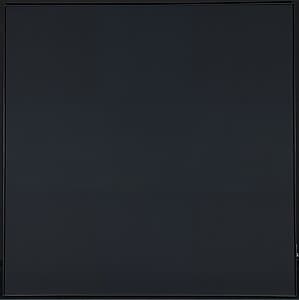

Ad Reinhardt
Learn morePainting 1954-1958 1954-58
© Ad Reinhardt. ARS/Copyright Agency Purchased 1973
More detail | PermalinkThe development of Ad Reinhardt’s black paintings began in 1948 when he abandoned cursive mark-making for a geometric style. His work became increasingly formalised over the next few years, evolving into rigidly vertical and horizontal shapes in red, blue or green paintings. The trisected composition―which divided the square canvas into nine equal squares―first appeared in 1952. By 1953 Reinhardt's work was predominantly monochromatic and increasingly monotonal and, from 1955, almost exclusively black. The black paintings assumed various shapes, usually tall and narrow, but including square paintings of various sizes such as Painting 1954–58. In 1960 Reinhardt further restricted the format of his work to five-foot square (152.6 x 152.6 cm), maintaining these dimensions for the rest of his life. The severity of the artist’s paintings seems to run parallel to his uncompromising critiques of modern art, published regularly in major art journals at this time. Reinhardt described his black works as the ‘ultimate’ or the ‘last paintings’ possible, and his uncompromising approach was highly influential, especially for Minimalism and conceptual art.[1]
Painting is larger than the size Reinhardt eventually decided was ideal, but the work anticipates the final configuration, a formula the artist described as:
A square ‘neutral, shapeless’ canvas, five feet wide, five feet high, as high as a man, as wide as a man’s outstretched arms ‘not large, not small, sizeless’, trisected ‘no composition’, one horizontal form negating one vertical form 'formless, no top, no bottom, directionless’, three ‘more or less’ dark ‘lightless’ no-contrasting ‘colorless’ colors, brushwork brushed out to remove brushwork, a matte, flat, free-hand painted surface ‘glossless, textureless, non-linear, no hard edge, no soft edge’ which does not reflect its surroundings—a pure, abstract, non-objective, timeless, spaceless, changeless, relationless, disinterested painting—an object that is self-conscious ‘no unconsciousness’ ideal, transcendent, aware of no thing but art ‘absolutely no anti-art’.[2]
The inscription in Reinhardt’s hand on the backing-board of the painting—‘ReinHardt 1954–1958’—is not necessarily a reliable guide to its dating. It was usual for Reinhardt to date his canvases as they left his studio for exhibition, according them the year they were first exhibited rather than the time he actually painted them. Months, even years, might elapse between the completion of a painting and its exhibition. The span dates inscribed by the artist may broadly refer to the completion of the work in that period or to continued work on the painting over that period. However, the extreme sensitivity of the surface of the black paintings (a single fingerprint can mar the entire painting) meant that Reinhardt frequently restored his works after exhibiting them. In repainting the surface he often changed the work and it has been suggested that the span dates indicate ‘that they were executed in two campaigns’.[3] The exhibition history and a second work, the only known painting with dimensions similar to those of Painting, would seem to confirm this dating.[4]
Michael Desmond and Michael Lloyd[5]
[1] Barbara Rose (ed), Art as art: The selected writings of Ad Reinhardt, University of California Press, Berkeley, 1991, p 13.
[2] ‘Autocritique de Reinhardt’, Iris Time, 10 June 1963, Newsletter of Galerie Iris Clert, Paris; reprinted in Rose, pp 82–3.
[3] Yve-Alain Bois, Ad Reinhardt, The Museum of Modern Art, New York, Museum of Contemporary Art, Los Angeles, 1991, np.
[4] To date there is no firm evidence to confirm an earlier exhibition than the showing at Dwan Gallery, Los Angeles, in 1963; moreover, the catalogue checklist for an exhibition at the Jewish Museum, New York, in the winter of 1966–67, prepared with the assistance of the artist, reiterates the 1954–58 date. The other work is Abstract painting, black 1954–56, private collection, Switzerland; see Bois, np.
[5] Adapted and updated from Michael Lloyd and Michael Desmond, European and American Paintings and Sculptures 1870–1970 in the Australian National Gallery, Australian National Gallery, Canberra, 1992, pp 274–6.

